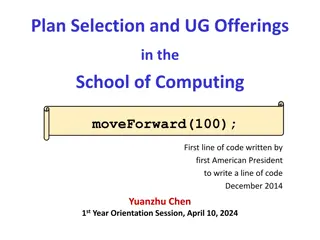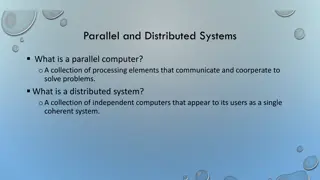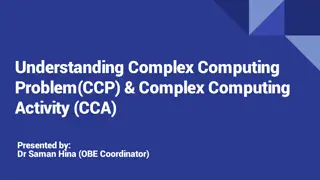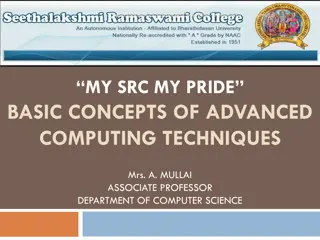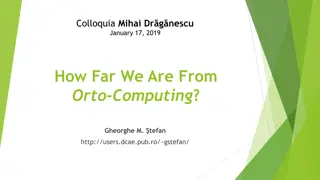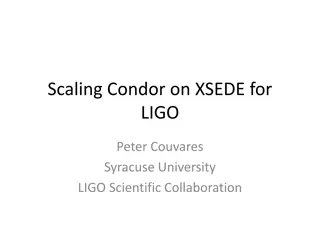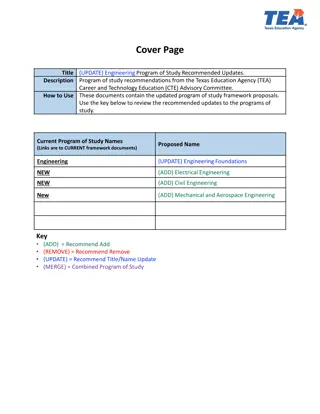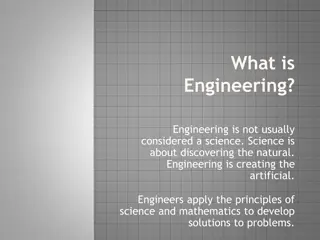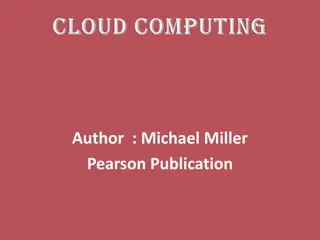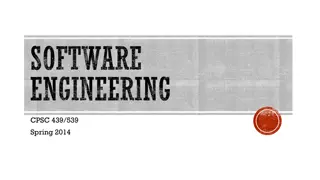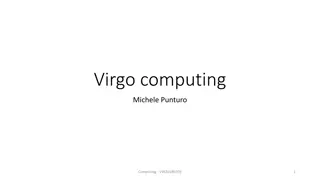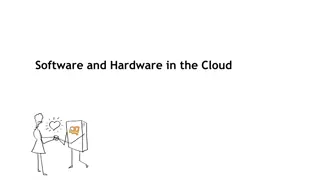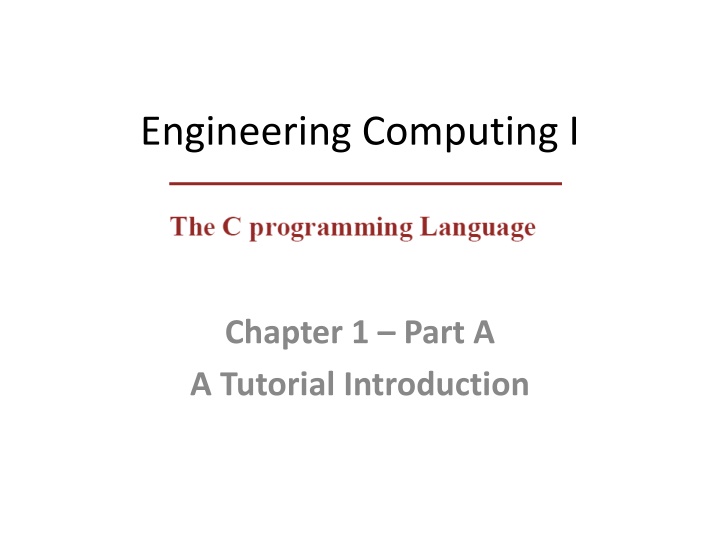
Introduction to Programming with C Language
Learn how to get started with the C programming language, from editing and compiling code to executing and debugging programs. Explore the basics of C, including its history, purpose, and step-by-step instructions on creating and running your first program.
Download Presentation

Please find below an Image/Link to download the presentation.
The content on the website is provided AS IS for your information and personal use only. It may not be sold, licensed, or shared on other websites without obtaining consent from the author. If you encounter any issues during the download, it is possible that the publisher has removed the file from their server.
You are allowed to download the files provided on this website for personal or commercial use, subject to the condition that they are used lawfully. All files are the property of their respective owners.
The content on the website is provided AS IS for your information and personal use only. It may not be sold, licensed, or shared on other websites without obtaining consent from the author.
E N D
Presentation Transcript
Engineering Computing I Chapter 1 Part A A Tutorial Introduction
C is a general-purpose programming language C is not a very high level language C was originally designed for UNIX Spring 2011 Chapter 1 - Part A 2
Getting Started Print the words: hello, world Spring 2011 Chapter 1 - Part A 3
How to execute a program? (Step 1- Editing) 1. Create and edit a C source file Open a Command/Terminal Window Use an Text Editor Create the file hello.c Enter the C code Save the file with a desirable path Spring 2011 Chapter 1 - Part A 4
How to execute a program? (Step2 - Compilation) 2. Compile the source file: Compile the source file hello.c using a C Compiler such as Microsoft cc.exe compiler or GNU for your machine (Windows32, MAC or Linux) Use the right compiler switches The compiler produces an object file (binary machine code) hello.bin Spring 2011 Chapter 1 - Part A 5
How to execute a program? (Step3 - Linking) 3. Link the source file to other object files: Link the object file hello.bin with the library files available in your machine using link.exe or similar programs. Library files are collections of pre-compiled relocate-able basic functions or API s. The Linker produces an executable binary file (machine code) hello.exe Spring 2011 Chapter 1 - Part A 6
Integrated Development Environment (IDE) In the IDE GUI environment: Enter and edit the source file Set Compiler and Linker switches Build Compile & Link Run Execute file in a command window Debug the file: Watch Variables Single Step Go to a braekpoint Spring 2011 Chapter 1 - Part A 7
Code Blocks Open source IDE Windows, MAC and Linux Versions Use GNU compiler/Linker Other IDEs: Microsoft Visual C++ Borland WATCOM etc. Spring 2011 Chapter 1 - Part A 8
Pull-Down Menu Code::Blocks IDE Text Editor Pull-Down Menu Logs , Reports, etc. Multi-Tab Windows Spring 2011 Chapter 1 - Part A 9
Your First C Program! Launch CodeBlocks in your machine Using Tool Bars: Carefully type in Hello, World program in a new C file. Save it as hello.c Build it. If any errors, correct and rebuild. Run The program. Repeat the above using icons. Spring 2011 Chapter 1 - Part A 10
Analysis of Program Functions Spring 2011 Chapter 1 - Part A 11
Variations to hello, World Spring 2011 Chapter 1 - Part A 12
Exercise Formatted List Write a program using escape characters \b , \t , \n , etc. to generate the following print out: Number Name Age ------------------------------- 1 John 20 2 Adam 18 3 Michael 20 Separate using tabs Save your program as: FormattedList.c Spring 2011 Chapter 1 - Part A 13
Exercise Large Letters Write a program using escape characters \b , \t , \n , etc. to print out large letters (A, B, ): * ** *** * * * * Save your program as: LargeLetter.c Spring 2011 Chapter 1 - Part A 14
Solution toExercise Large Letters Spring 2011 Chapter 1 - Part A 15
Variables and Arithmetic Expressions Spring 2011 Chapter 1 - Part A 16
Variables and Arithmetic Expressions Pseudo Code for Fahrenheit to Celsius Conversion Program: lower= 0; step = 20; upper = 300 fahr = lower; while fahr <= upper { celsius = (5/9)*(fahr-32) print far and celsius } Spring 2011 Chapter 1 - Part A 17
Binary Arithmetic Operations Operation Addition Subtraction Multiplication Division Symbol + - * / Spring 2011 Chapter 1 - Part A 18
Fahrenheit to Celsius Spring 2011 Chapter 1 - Part A 19
Tutorial on Numbers: Signed & Unsigned Integers 1. Whole Numbers: 1, 2, 3, 2. Whole Numbers plus 0: 0, 1, 2, 3, 3. Whole Numbers with Positive or Negative Signs plus 0: , -3, -2, -1, 0, 1, 2, 3 Unsigned Integers Unsigned Integers Spring 2011 Chapter 1 - Part A 20
Tutorial on Numbers: Signed & Unsigned Integers 4-bit example unsigned signed 0, 1, 2, , 24 - 1 -23 , -23+ 1, , -1, 0, 1, , 23 - 1 0 0 0 0 0 8 1 0 0 0 0 0 0 0 0 -8 1 0 0 0 1 0 0 0 1 9 1 0 0 1 1 0 0 0 1 -7 1 0 0 1 2 0 0 1 0 10 1 0 1 0 2 0 0 1 0 -6 1 0 1 0 3 0 0 1 1 11 1 0 1 1 3 0 0 1 1 -5 1 0 1 1 4 0 1 0 0 12 1 1 0 0 4 0 1 0 0 -4 1 1 0 0 5 0 1 0 1 13 1 1 0 1 5 0 1 0 1 -3 1 1 0 1 6 0 1 1 0 14 1 1 1 0 6 0 1 1 0 -2 1 1 1 0 7 0 1 1 1 15 1 1 1 1 7 0 1 1 1 -1 1 1 1 1 Spring 2011 Chapter 1 - Part A 21
Tutorial on Numbers: Signed & Unsigned Integers - Size 1. char 8 bits 2. Small size int short int 3. Medium Size int 4. Large Size long int Spring 2011 Chapter 1 - Part A 22
Tutorial on Numbers: Example: size on 32-bit machine char 8 bits short int 16 bits int 32bits long int 32 bits Spring 2011 Chapter 1 - Part A 23
Tutorial on Numbers: Examples on 32-bit machine Unsigned Signed 0 .. 28 -1 -27 .. 27-1 Char 0 .. 255 -128 .. 127 0 .. 216-1 -215 .. 215-1 int 0 .. 65535 -32768 .. 32767 0 .. 232 -1 -231 .. 231-1 long 0 .. 4294967295 -2147483648 .. 2147483647 Spring 2011 Chapter 1 - Part A 24
Exercise Find the signed and unsigned ranges for 64-bit integers A C Compiler is to be designed for a 4-bit microprocessor. Come up with relevant sizes for the following types: char int long Spring 2011 Chapter 1 - Part A 25
Floating Point The IEEE Standard for Floating-Point Arithmetic (IEEE 754) is the most widely-used standard for floating-point computation ( 1)s c 10q Example: S=1 c=12345 q=-3 =-12.345 Spring 2011 Chapter 1 - Part A 26
Float, double Common name Name Base Digits E min E max Single precision binary32 2 23+1 -126 +127 Double precision binary64 2 52+1 -1022 +1023 Spring 2011 Chapter 1 - Part A 27
Testing Different Sizes Using sizeof() function, write a short program to determine the size of different types of variables on your machine. Spring 2011 Chapter 1 - Part A 28
Fahrenheit to Celsius More Accuracy Spring 2011 Chapter 1 - Part A 29
Width & Precision Spring 2011 Chapter 1 - Part A 30
Exercises Spring 2011 Chapter 1 - Part A 31
Solution toExercise 1.3 Spring 2011 Chapter 1 - Part A 32
Solution to Exercise 1.4 Spring 2011 Chapter 1 - Part A 33
The For Statement Body of Loop Initialization Condition Increment Spring 2011 Chapter 1 - Part A 34
Symbolic Constants Spring 2011 Chapter 1 - Part A 35

